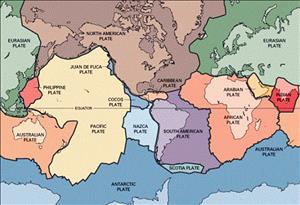Land formations in Washington and the Pacific Northwest were a result of millions of years of changes in weather conditions and the environment. Glaciers and other geological forces created islands, mountains, lakes, and other specific land formations. (This essay was written for students in third and fourth grade who are studying Washington State History and for all beginning readers who want to learn more about Washington. It is one of a set of essays called HistoryLink Elementary, all based on existing HistoryLink essays.)
Making Land
About 100 million years ago, during what is called the Mesozoic Era, a huge land mass called the Okanogan Terrane crashed into the western side of the North American continent. This type of geological event, in which two land masses join together permanently, is called a docking. So the Okanogan Terrane became part of the existing continent. As a result, the coastline of the Pacific Northwest extended out into the ocean by about 50 more miles.
The next documented terrane docking occurred 50 million years later during the Eocene Era. The North Cascades Terrane rammed into the North American continent, also adding to the size of the western portion of the North American continent.
The final group of terrane dockings began 15 million years ago and continued for several million years. During these dockings, several major changes to the geography of the region took place. The San Juan Islands were formed. The Olympic Mountains were pushed up. And the bottom of the edge of the coastline -- called the Pacific Plate -- was pushed down. A low area, called a trough, formed between the mountains. Over time, water filled in the trenches and formed Puget Sound. This all took place during the beginning of the Pleistocene Epoch which is also often called the Ice Age.
During this period, glaciers covered the Puget Sound region at least seven different times. The Vashon Glacier was the last of the glaciers. It covered land from Olympia to Spokane, except for the higher mountain peaks. In some places, the ice was 3,000 feet deep.
Then, about 15,000 years ago, the glacier began to melt. In eastern Washington, temporary ice dams holding billions of gallons of meltwater were formed. When these dams became weak and burst, huge floods created Grand Coulee and the Channeled Scablands. The retreating ice sheet left other lasting changes to the landscape. Lake Chelan was formed when meltwater collected in one of the large depressions left behind by the heavy ice.
On the west side of the Cascade Mountains, two large ice lobes covered what is now called the Puget Lowlands. The glacier split into two lobes around the Olympic Mountains. The Juan de Fuca Lobe moved west and the Puget Lobe moved south towards what is now the Seattle area. As it moved, the Puget Lobe left behind huge piles of clay, sand, soil, rock, and mud. Water from the melting ice carved valleys as it moved under the glacier. This is how Puget Sound, Lake Washington, Lake Union, Lake Tapps, and Lake Sammamish were formed.
After the glacier melted and it became warmer, the bare land gradually was covered with forests and other native plants. Fossils of horses, bison, mammoths, mastodon, and other animals have been found. That is proof that there has been life in this region for many thousands of years. Most archaeologists believe that human beings did not live in the Puget Sound region until some time after the Ice Age ended. This is mainly because the weather conditions during the Ice Age would have made it very difficult for humans to survive.

